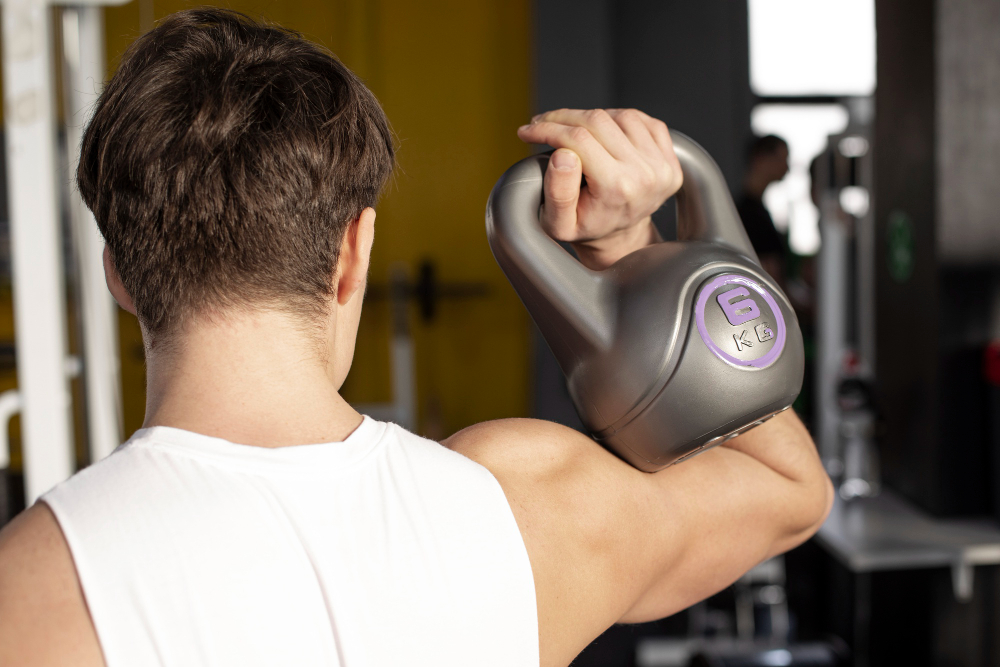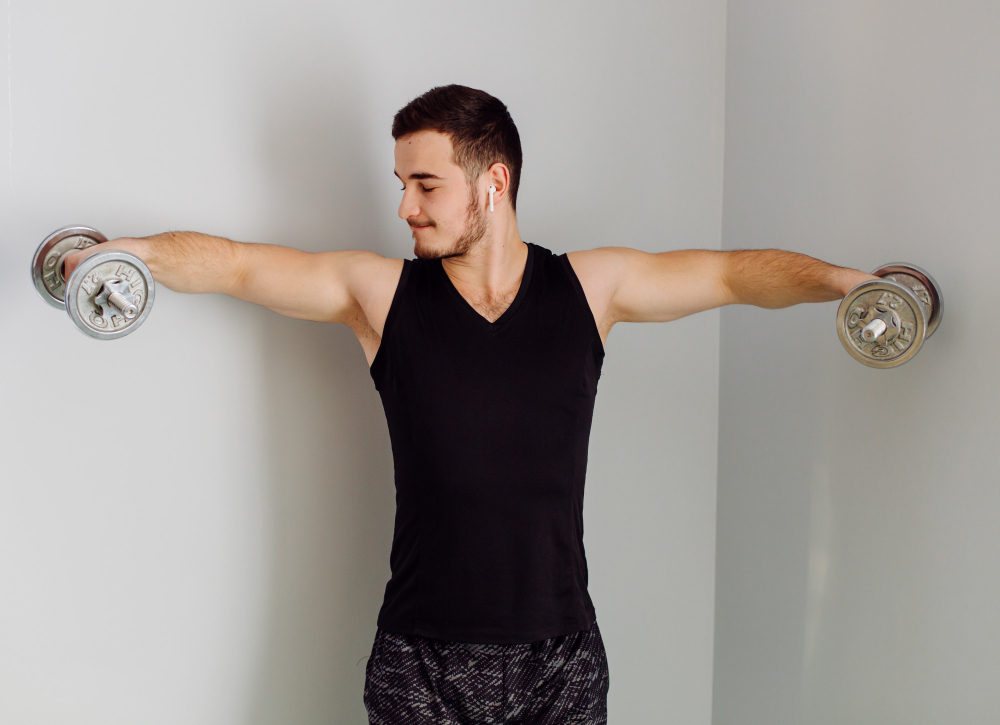Effective Shoulder Workout Routine: 7 Moves for Stronger Delts

Are your shoulders getting the attention they deserve? If you’re like most gym-goers I’ve worked with over my decade as a fitness trainer, the answer is probably “not quite.” While chest and arm days seem to dominate workout schedules, a dedicated shoulder workout routine can be the game-changer your upper body needs.
Table of Contents
I learned this lesson the hard way. For years, I focused on bench presses and bicep curls, wondering why my physique looked unbalanced. It wasn’t until I committed to a structured shoulder workout routine that my upper body finally achieved that coveted V-taper look that transforms your entire appearance.
In this guide, I’m sharing the exact shoulder workout routine that’s helped hundreds of my clients transform their upper bodies from ordinary to extraordinary. These seven moves target all three deltoid heads plus the supporting muscles that create truly sculpted arms and shoulders that command attention.
Why Your Shoulders Deserve Special Attention

Before diving into the workout routine, let’s talk about why shoulders matter so much. Your shoulders are involved in virtually every upper body movement you make, from picking up groceries to reaching for objects on high shelves. They’re also front and center in how your physique appears in t-shirts, button-ups, and tank tops.
A well-developed shoulder complex:
- Creates the illusion of a smaller waist
- Makes your arms look bigger and more defined
- Improves posture and reduces risk of injury
- Enhances performance in nearly all sports and physical activities
Yet despite these benefits, I see too many people treating shoulder training as an afterthought. The result? Muscle imbalances, limited mobility, and a physique that lacks that “wow” factor.
The Complete 7-Move Shoulder Workout Routine
This shoulder workout routine hits all three deltoid heads (front, side, and rear) while also engaging the traps, rotator cuff, and supporting muscles. For best results, perform this routine 1-2 times per week with at least 48 hours of recovery between sessions.
1. Standing Military Press
The military press is the king of shoulder exercises, and it deserves its place at the start of your shoulder workout routine. This compound movement primarily targets the anterior (front) deltoid while engaging the medial deltoid and triceps as secondary movers.
How to perform:
- Stand with feet shoulder-width apart, holding a barbell at shoulder height with palms facing forward
- Brace your core and slightly tuck your pelvis
- Press the weight overhead until arms are fully extended
- Lower slowly back to starting position
Sets and reps: 4 sets of 8-12 reps Rest period: 90-120 seconds
Pro tip: Don’t arch your back to push the weight up. If you find yourself doing this, reduce the weight to maintain proper form and protect your lower back.
2. Seated Dumbbell Press
After hitting the shoulders with a barbell, we switch to dumbbells for more balanced development and to address any strength imbalances between your left and right sides.
How to perform:
- Sit on a bench with back support, holding dumbbells at shoulder height
- Press the weights overhead until arms are almost fully extended (leave a slight bend in the elbows at the top)
- Lower slowly back to starting position
Sets and reps: 3 sets of 10-12 reps Rest period: 60-90 seconds
Pro tip: Try the Arnold press variation by starting with palms facing you, then rotating as you press up so your palms face forward at the top.
3. Lateral Raises
Now we move to isolation work, beginning with the medial (side) deltoid. The lateral raise is unmatched for developing that shoulder width that makes your waist look smaller.
How to perform:
- Stand holding dumbbells at your sides, palms facing your body
- With a slight bend in your elbows, raise the weights out to the sides
- Stop when arms are parallel to the floor
- Lower slowly with control
Sets and reps: 3 sets of 12-15 reps Rest period: 60 seconds
Pro tip: If you’re struggling with form, try the “empty can” technique—imagine pouring water from a can as you lift, rotating your thumbs slightly downward. This increases medial delt activation.
4. Front Raises
Although your front delts get significant work during presses, adding front raises ensures complete development of this highly visible muscle group.
How to perform:
- Stand holding dumbbells in front of your thighs
- Keeping arms straight with a slight elbow bend, raise one dumbbell forward and up to shoulder height
- Lower and repeat with the other arm
- Alternate arms for the prescribed reps
Sets and reps: 3 sets of 12 reps (each arm) Rest period: 60 seconds
Pro tip: You can also perform these with both arms simultaneously, but I’ve found alternating allows for better focus on each side.
5. Bent-Over Rear Delt Flyes
Rear delts are the most neglected part of the shoulder complex, yet they’re crucial for balanced development and preventing the hunched-forward posture that comes from too much chest work without proper posterior chain training.
How to perform:
- Bend at the hips until your torso is nearly parallel to the floor
- Hold dumbbells with palms facing each other
- Keeping a slight bend in the elbows, raise the weights out to the sides
- Squeeze your shoulder blades together at the top
- Lower slowly with control
Sets and reps: 3 sets of 15 reps Rest period: 60 seconds
Pro tip: Imagine pinching a pencil between your shoulder blades at the top of the movement to maximize rear delt engagement.
6. Face Pulls
This underrated exercise targets the rear delts and upper traps while also engaging the rotator cuff muscles—crucial for shoulder health and stability.
How to perform:
- Set a cable pulley to upper chest height
- Attach a rope handle and grasp it with palms facing each other
- Step back to create tension in the cable
- Pull the rope toward your face, separating your hands as you pull
- Focus on pulling with your rear delts, not your biceps
- Return slowly to starting position
Sets and reps: 3 sets of 12-15 reps Rest period: 60 seconds
Pro tip: Don’t rush this movement! The tempo should be controlled—take 2 seconds to pull, hold for 1 second at the contraction, and take 3 seconds to return to the starting position.
7. Shrugs
We finish the shoulder workout routine by hitting the upper traps, which create that powerful look between your shoulders and neck.
How to perform:
- Stand holding dumbbells or a barbell with arms extended
- Lift your shoulders straight up toward your ears
- Hold the contracted position briefly
- Lower slowly with control
Sets and reps: 3 sets of 12-15 reps Rest period: 60 seconds
Pro tip: Don’t roll your shoulders—straight up and down is the most effective movement pattern. Adding a 2-second hold at the top significantly increases trap activation.
Making This Shoulder Workout Routine Work for You
The beauty of this shoulder workout routine is its adaptability. Here’s how to customize it to your fitness level:
For beginners: Start with lighter weights and focus on perfecting form before increasing loads. You might begin with just 3 exercises from this routine: military press, lateral raises, and rear delt flyes.
For intermediate lifters: Follow the routine as written, ensuring progressive overload by increasing weight or reps each week.
For advanced lifters: Add drop sets to the last set of each exercise or incorporate techniques like rest-pause training to increase intensity.
Remember, the key to shoulder development isn’t just working hard—it’s working smart. Having trained hundreds of clients through this shoulder workout routine, I’ve seen firsthand that consistency trumps intensity every time.
Nutrition to Support Your Shoulder Workout Routine
Your shoulder workout routine won’t deliver maximum results without proper nutritional support. Here’s what I recommend:
- Protein intake: Aim for 1.6-2.0g per kg of bodyweight daily to support muscle repair and growth
- Pre-workout nutrition: Consume a balanced meal with carbs and protein 2-3 hours before your shoulder workout routine
- Post-workout nutrition: Have a protein shake with 25-30g of protein within 30 minutes after completing your workout
- Hydration: Drink at least 3 liters of water daily, with 500ml during your workout
These nutritional strategies enhance recovery between shoulder workouts and maximize the muscle-building stimulus from your training.
Common Mistakes to Avoid in Your Shoulder Workout Routine
After years of coaching clients through this shoulder workout routine, I’ve identified these common mistakes:
- Using momentum: Swinging weights reduces tension on the target muscles and increases injury risk
- Neglecting warm-ups: Cold shoulders are vulnerable shoulders—do 5 minutes of arm circles, band pull-aparts, and light lateral raises before starting
- Training shoulders after chest: This reduces your shoulder performance—give them their own dedicated day
- Skipping rear delts: This creates imbalances that can lead to rounded shoulders and potential rotator cuff issues
- Lifting too heavy: Shoulders respond better to moderate weights with perfect form than heavy weights with sloppy execution
Tracking Progress in Your Shoulder Workout Routine
How do you know if your shoulder workout routine is working? Look for these signs:
- Increased strength in pressing movements
- Visible muscle definition, especially at the side deltoid
- Improved performance in other upper body exercises
- Better posture and shoulder mobility
- T-shirts fitting more snugly around the shoulders
I recommend taking progress photos every 4 weeks and recording your weights and reps in a workout journal or app. This provides objective feedback on your development.
Final Thoughts on Your New Shoulder Workout Routine

Transforming your shoulders doesn’t happen overnight. The shoulder workout routine I’ve shared here has helped countless clients achieve impressive results, but it requires patience and consistency.
Start implementing this routine today, focus on progressive overload (gradually increasing weight or reps), and give your body adequate recovery time. Within 8-12 weeks, you’ll notice significant improvements in both strength and aesthetics.
Your shoulders contribute enormously to your overall physique and functional strength. By giving them the dedicated attention they deserve with this comprehensive shoulder workout routine, you’re investing in both your appearance and your physical capability.
Ready to get started? Block out 45-60 minutes in your schedule twice a week, grab those dumbbells, and get ready for shoulders that turn heads and boost confidence. Your future self will thank you for making this shoulder workout routine a priority.
Meta Description: Transform your upper body with this proven shoulder workout routine. These 7 essential moves target all deltoid heads for stronger, more sculpted arms and shoulders.
